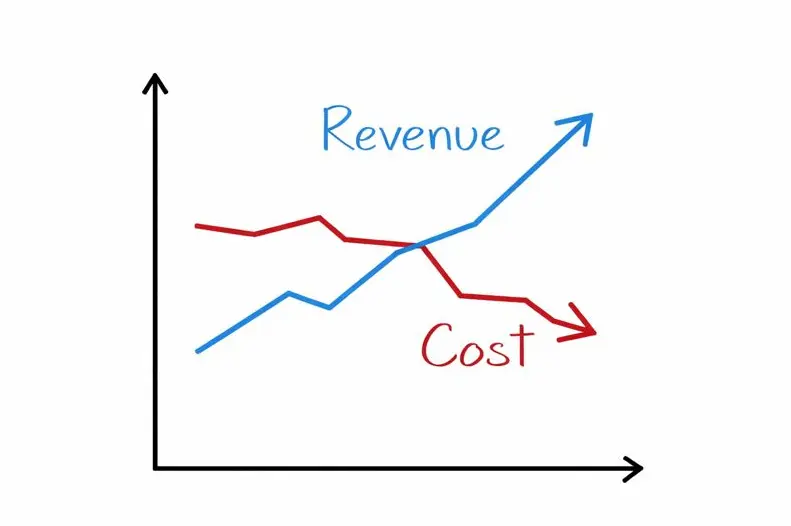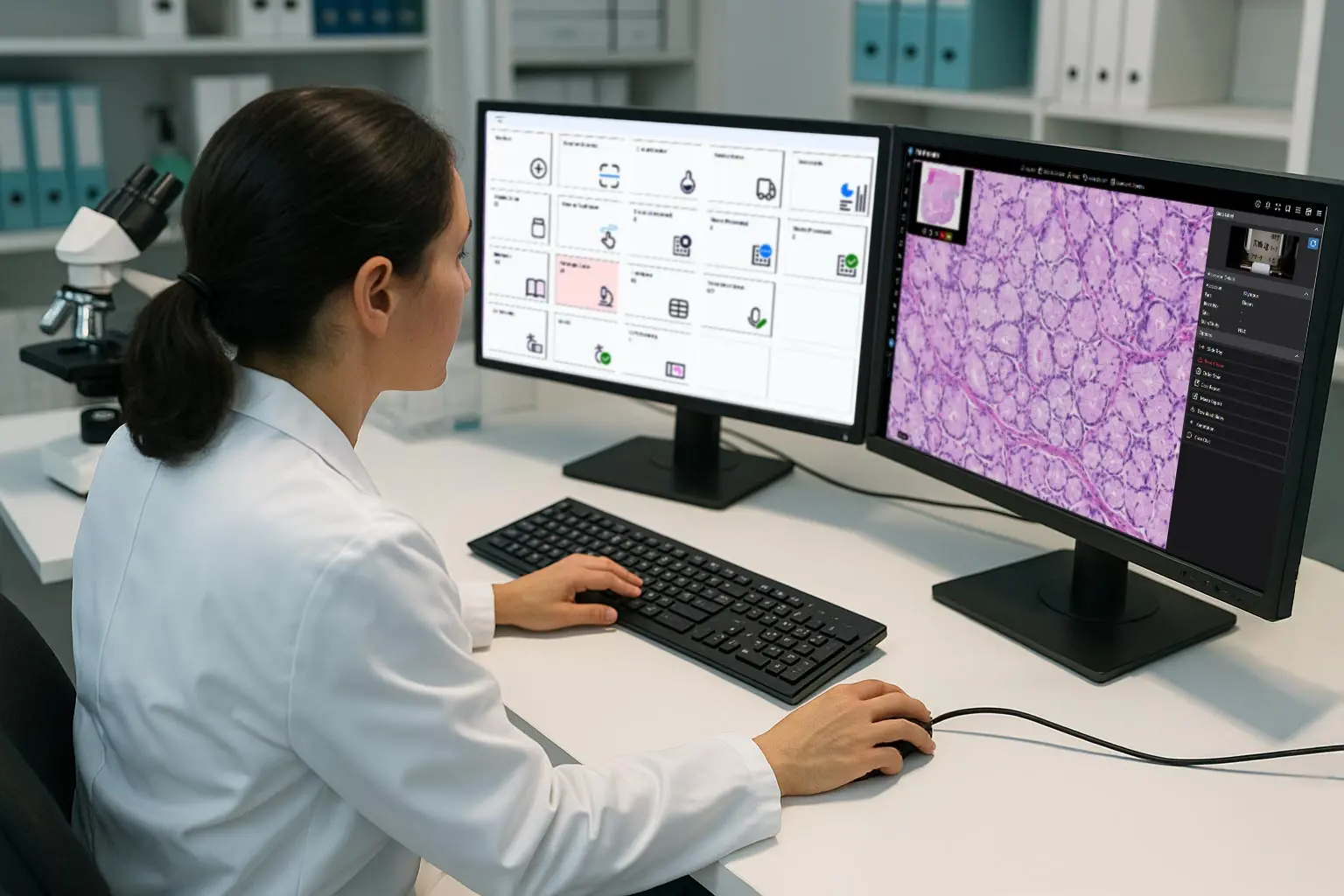Blog
Market Differentiation and Unmatched Customer Service: Two Major Reasons Why You Should Consider LigoLab for Your LIS System Upgrade
July 28, 2025
The benefits associated with new technology are incredible, especially when it comes to streamlining and optimizing clinical labs and pathology groups. Words like increased efficiency, enhanced productivity, and cost savings are often part of the siren song that lures even the most change-resistant lab managers away from their current technologies.
Unfortunately, the excitement of a new laboratory information system (LIS software) can quickly give way to disappointment if the lab chooses the wrong LIS company to partner with.
This is not to say that lab leaders shouldn’t upgrade their laboratory information systems; quite the contrary. Given the current environment, upgrading to a robust medical LIS software that can handle a lab’s current and future requirements is a must.
“Modern laboratory information systems streamline and automate several tasks, creating a leaner, more competitive, and efficient operation while providing complete visibility into all business processes,” said LigoLab CEO Suren Avunjian.
When evaluating LIS vendors, lab decision-makers need to consider more than just the marketing hype. They need to examine the entire pathology management software package to see what the best LIS software can do in terms of market differentiation for their business.
What are the LIS system’s features?
Where does the LIS system rank in functionality?
Is it adaptable?
Is the LIS medical solution scalable?
What’s the pricing and incentive model?
What about the level of customer service?
Is the LIS company interested in investing in the organization long-term, or just selling pathology lab software with a high upfront cost and no long-term plan for success?
“The need to differentiate is a major reason why lab managers choose laboratory information system software like ours,” said Avunjian. “Modern LIS systems and the LIS software vendors that support them create differentiation by providing labs unique advantages in their marketplaces, enabling them to easily support and retain the clients they already have while attracting and expanding new sources of clients and revenue.”
Why Modern LIS Systems Like LigoLab Are Disrupting the Lab Market with Unmatched Support and Scalability
Avunjian noted that across the country, labs are using similar equipment, and they all have the same board-certified medical directors. Because of this, modern LIS systems, such as LigoLab’s LIS & RCM Laboratory Informatics Platform, have become key market disruptors, enabling some labs to rise in terms of features, functionality, and scalability.
For LigoLab in particular, the LIS company offers a future-ready informatics platform and unlimited and unmatched customer service from its best-in-class personnel. This level of LIS system support, unfortunately, isn’t the norm. It begins on Day One of the implementation process and continues to go live and beyond.
“When you upgrade to a modern lab information system, you gain that all-important partnership with your LIS system provider and all the help – from implementation and training to tech support and community membership – that they have to offer,” said Avunjian. “For us as enterprise medical laboratory information system vendors, we view every interaction with a lab partner as an investment back into our company.”
In 20 years of doing business, not a single customer has decided on their own to migrate from LigoLab’s comprehensive platform to an alternative medical LIS solution.
“I think that speaks volumes about our laboratory information system software, and also our customer service,” continued Avunjian.
Industry Insights: The Rise and Fall of CoPath LIS - A Legacy Casualty of the Modern Lab Information System Era

A Lab-First Philosophy for Laboratory Information System Implementation
So, how does LigoLab’s customer-first philosophy shape LIS system Implementation?
“We treat every LIS implementation as if we’re building the system for ourselves,” said Petros Martirosian, LigoLab’s Implementation Director. “That means we bring our expertise and best practices to the table, but we never force a one-size-fits-all approach. Instead, we collaborate closely with our lab partners and adjust our process to meet their unique operational needs.”
Since 2006, LigoLab has continually refined its implementation process for its adaptable all-in-one laboratory informatics platform.
“We break implementation into four high-level phases,” Martirosian explained, “and each one is carefully structured to ensure a smooth and successful system deployment.”
Discover More: LigoLab’s Approach to LIS System Implementation and Support

LigoLab’s Four-Phase LIS System Implementation Process:
Step 1: Discovery
The implementation journey begins with an in-depth analysis. During this phase, LigoLab maps out every detail of the lab’s current operations—including workflows, instruments, integrated laboratory software systems, and tools—to gain a full understanding of existing practices. With this foundation, the implementation team identifies opportunities for optimization and collaborates with key stakeholders (such as the lab’s interface team, lab billing team, and third-party developers).
Step 2: Configuration
Once the lab’s operational framework is fully understood, LigoLab begins configuring the LIS system. This includes setting up master files, followed by building out workflows tailored to the lab’s needs. At this stage, user training also begins, enabling staff to validate the setup and ensure it aligns with real-world processes.
Step 3: Testing & Validation
With configuration complete, the new LIS system enters the testing phase. For a minimum of two weeks, the lab processes (simultaneously) all case types in both the legacy LIS software and the LigoLab platform. This parallel testing helps identify any discrepancies and ensures a smooth transition with minimal risk of disruption.
Step 4: Go-Live
After successful validation, the lab transitions to live operations using the new laboratory information system. LigoLab’s implementation team remains fully engaged during the first two weeks post-launch, working closely with the lab team to resolve any issues and fine-tune the system for peak performance.
On average, LigoLab completes full LIS system implementations in just two months—a significant improvement over the industry norm, where timelines are often measured in years.
Discover More: Keys to Keeping Your LIS System Implementation on Track
LigoLab Never Leaves Its Lab Information System Partners Out in the Cold
The end of laboratory information system implementation doesn’t mean an end to LigoLab’s support and hand-holding. In fact, in many ways, it merely marks the beginning.
“At the point where the implementation team drops off, the support team takes over,” said Martirosian. “To our lab partners, the transition is seamless. They inherit a dedicated team with intimate knowledge of their LIS system that can quickly resolve any reported issues.”
To help ensure that potential issues get resolved appropriately and without delay, LigoLab’s support team works within a three-tiered structure. Each support tier is focused on solving a specific range of complexities. For every type of incoming request, there’s a specialized team member who’s qualified to resolve the issue. This tiered system enables the support team to triage and escalate its response to match the present issue at hand.
Here’s how it works:
- Level 1
The lab emails or calls LigoLab to report an issue. That automatically triggers a service request sent to a level one engineer. The ticket is read, and if additional information is required, LigoLab contacts the lab customer. If the ticket cannot be resolved in level one for any particular reason, it gets escalated to level two.
- Level 2
Level two of the support team receives the service request with additional, relevant input from level one. The level two team is composed of experienced engineers who also have access to LigoLab’s Developer On Call (DOC). After a service request reaches level two support, the engineers themselves work on the solution. If they can’t resolve the issue, it gets escalated to the DOC for assistance.
- Level 3
If the issue can’t be resolved by the DOC or level two engineers, it gets escalated to level three, a level composed of LigoLab’s elite LIS software developers.
At every stage of the support process, engineer performance is evaluated through a structured approach that includes categorizing each request and assigning an internal service level agreement (SLA). Peers and managers review each request to ensure it’s properly prioritized and assigned an appropriate turnaround time.
As issues are escalated, SLAs are adjusted to reflect urgency, and an initial assessment is performed at each level to confirm the problem has been escalated correctly and will receive the fastest possible resolution.
Completed requests may be randomly selected for quality assurance review. This not only helps evaluate engineer performance but also promotes the sharing of best practices and knowledge across the entire team.
LigoLab’s support team is available 24/7 at no additional cost to the customer, enabling rapid response and the ability to fast-track issues when necessary. In most cases, customers receive a diagnosis, resolution, or a clear timeline for resolution within 24 hours.
Discover More: Questions All Pathology Labs Should Ask When Evaluating LIS Software and Support

What About Laboratory Information System Updates?
Another important aspect of LigoLab’s lab-first philosophy is the laboratory information system vendor’s approach to platform upgrades and updates.
LigoLab’s medical LIS solution is actively improving and expanding to meet the growing needs of its clinical laboratory and pathology practice customers.
“We take great pride in our responsive service and in listening to our customers,” said Emanuel Basag-Taroata, a key contributor to LigoLab’s Customer Success team.
“We are a dynamic team, and all our lab partners benefit from this agility. The platform is continuously evolving. At the same time, we regularly ask for customer feedback because if we can develop features that help our customers differentiate and become even more productive, it’s good for the entire LigoLab ecosystem of labs,” he said.
Industry Insights: Laboratory Information Systems and Their Key Role in Lab Data Analytics
How Often is LigoLab’s LIS Software Updated?
LigoLab consistently designs new features and functionality for its LIS software platform, and all updates can be added to a lab organization’s testing, training, and production environments at any time. However, to make the process less cumbersome, LigoLab also provides quarterly platform updates.
Labs have the flexibility to opt in or out of LIS software updates. However, it's important to note that any version not updated within two years will reach its end of life and expire.
“All that a lab manager has to do to reference our latest updates is click the version features button embedded within the application,” added Basag-Taroata. “They can see what’s new instantly. All the latest features and their explanations are listed chronologically on this page.”

Updates to the laboratory information system software are performed nightly, but this doesn’t impact the customer’s live version.
“Once an upgrade request is made, we work closely with that lab to schedule the update to their liking,” said Basag-Taroata.
Discover More: A Closer Look at LigoLab’s Commitment to Innovation
How Long Does a Laboratory Information System Upgrade Take?
“During the great majority of the laboratory information system update process, there is no downtime,” said Basag-Taroata. “The only real downtime is when the lab’s updated training environment gets turned into a production environment. The downtime differs for each customer, depending on the server performance and the database size, but, in general, the bigger the version jump, the more time it will take to complete the upgrade.”
The final phase of the upgrade process begins by taking the lab’s production system offline and logging out all active users. LigoLab then creates a full backup of the current environment to safeguard against potential issues.
If any issues do occur, they receive top priority in LigoLab’s service queue. Most bugs are resolved within hours, and the full upgrade is typically completed within a single day.
“We work closely with our lab partners throughout every stage of the upgrade,” said Basag-Taroata. “They’re informed of the timeline and steps in advance, so there are no surprises. It’s a collaborative effort.”
To ensure speed and accuracy, LigoLab follows a strict policy of upgrading only one customer at a time, minimizing risk and maximizing support during the transition.
Industry Insights: Is Software Testing a Lost Art?
How the Laboratory Information System Upgrade Process Works
To initiate a lab information system upgrade, a formal request from the lab partner is all that’s required. This begins the process, with LigoLab’s award-winning support team taking on the heavy lifting.
Step #1: The lab decides if it wants to upgrade its LIS system.
To see the latest LIS software version, lab personnel can simply click the top menu within the application (click on “system” and then “version features”). When something new catches their attention, they start the upgrade process by contacting the support team.
Step #2: Preparing for the LIS upgrade.
As soon as an upgrade request comes in, LigoLab configures a training environment to mirror the production environment of the latest version of the laboratory information system software.
Step #3: Coordinated communication between the lab and the support team.
The support team stays in close communication with the lab to ensure a seamless transition. This includes verifying that all active projects configured in the training environment are successfully replicated in the production environment and that the latest LIS software configuration is accurately reflected in the live system.
Step #4: A backup environment is created.
Once all configurations have been synchronized between the production and training environments, the support team creates a backup environment that guards against any issues that may occur during the update.
Step #5: The laboratory information system is validated.
A copy of the lab’s production environment is brought over to LigoLab’s training environment, and the LIS system upgrade is initiated. Next, the LIS system is analyzed to ensure the new version includes all of the updates the lab has requested.
Step #6: Regression testing.
This is where any issues are identified and immediately fixed. Regression testing involves a set of test cases (or test suites) and a lab workflow that goes through the application from start to finish. Every time a developer makes a change to the code, a series of automated test cases is triggered. If part of the new code is broken or if any of the outcomes are unsatisfactory, the developer is alerted.
Regression testing helps eliminate many of the frustrations and headaches that typically come with an update. In addition, LigoLab uses a proprietary solution known as Hydra to test if the new version will break on the lab’s server. The development team accomplishes this by pointing Hydra at the lab’s server and recreating all of the lab’s orders from the previous 10 days, releasing them all at once to see if any errors or issues surface.
Step #7: The lab begins its testing.
After all of the issues have been identified and corrected, the support team hands the new training environment back over to the lab so that its personnel can commence testing.
It’s recommended that the lab test the LIS system from end to end to make sure that everything is in order before the upgrade to the production environment takes place. During this testing period, the lab reports any bugs or errors, and they are addressed urgently by the support team before the version is moved to production.
Step #8: The Go-live is scheduled, and the LIS system upgrade is triggered.
After all remaining issues have been addressed and the support team has received the go-ahead from the lab to deploy the upgrade in the production environment, both the lab and the support team agree on a timeframe for the upgrade to commence.
On-Demand Webinar: Has Our Laboratory Outgrown Its Laboratory Information System?
How Does LigoLab Decide When and What to Update?
“When we design LIS system upgrades, we look ahead to where technology trends are taking the industry and anticipate what our lab partner’s future needs will be,” said LigoLab COO Gor Kalantaryan. “We also design new features based on customer requests, which get included into one code base slated to be part of our normal update to the rest of our laboratory partners.”
When a lab requests a new LIS system feature, there are two possible paths. If the feature aligns with LigoLab’s development roadmap and timeline, it's added at no additional cost. However, if the feature is critical and requires immediate development, LigoLab provides a (do-not-exceed) quote for the expedited work and prioritizes the request.
“In both scenarios—whether it follows our schedule or is fast-tracked for a specific lab—all customers ultimately benefit,” said Kalantaryan. “The new feature becomes part of the latest version of our laboratory information system software. Our customers form a community, and as a forward-thinking LIS company, we’re committed to helping all of them eliminate growth barriers, enhance efficiency, and increase profitability.”
Industry Insights: Building vs. Buying Laboratory Information Systems (LIS) - Dispelling Some Common Myths
Best-in-Class Personnel With a Specialty in Advanced LIS Software Development
At LigoLab, we partner with our LIS system customers and take FULL RESPONSIBILITY for their lab informatics.
The all-in-one LigoLab Medical LIS & Lab Billing Informatics Platform fuels business growth and digitally transforms laboratories into information-driven and future-ready operations thanks to:
- A comprehensive and infinitely configurable enterprise-grade laboratory information system software application
- Powerful and fully integrated modules that provide end-to-end support for all lab workflow (including anatomic pathology, clinical laboratory, molecular diagnostics, laboratory revenue cycle management, and direct-to-consumer lab testing)
- Aligned pricing tiers, unlimited support, no hidden fees, and no limit on seats or modules
Learn more about the market’s most flexible and comprehensive laboratory information system. Schedule your LIS software demo today.
Speak with a LigoLab Product Specialist!






